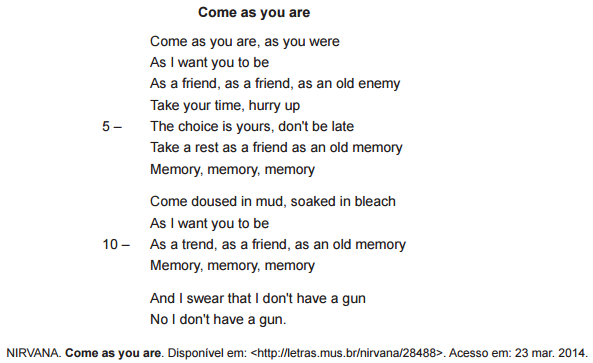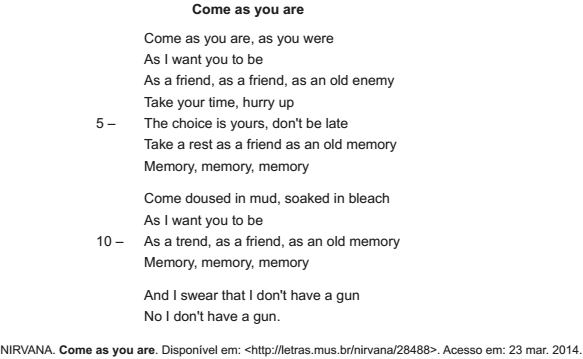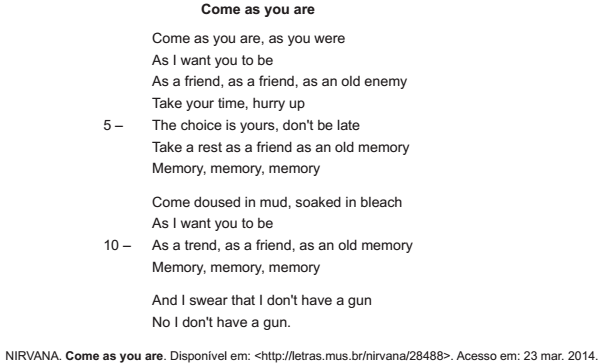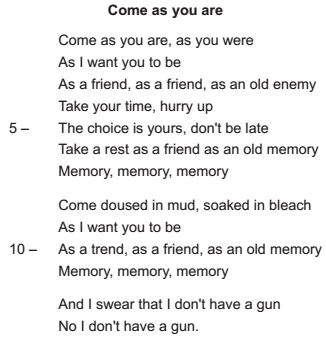Questões de Inglês - Passado simples | Simple past para Concurso
Foram encontradas 257 questões
Choose the correct answer for each gap below:
He ______ so many languages fluently.
I think you ______ quit smoking.
She ______ me that she would be here by now.

Marque C,se a proposição é verdadeira; E,se a proposição é falsa.
As formas verbais “are” (v.1) e “were” (v.1) descrevem, respectivamente, a oposição de tempo presente e de tempo passado.
Read the sentences below:
I. John study engineering at my university.
II. Helene is going to live in London last year.
III. Pedro wishes he can read more this month.
IV. When I grew up, I want to be a jazz singer.
Choose the best alternative to replace the words underlined in the sentences above:
TEXT II
The backlash against big data
[…]
Big data refers to the idea that society can do things with a large body of data that weren’t possible when working with smaller amounts. The term was originally applied a decade ago to massive datasets from astrophysics, genomics and internet search engines, and to machine-learning systems (for voice-recognition and translation, for example) that work well only when given lots of data to chew on. Now it refers to the application of data-analysis and statistics in new areas, from retailing to human resources. The backlash began in mid-March, prompted by an article in Science by David Lazer and others at Harvard and Northeastern University. It showed that a big-data poster-child—Google Flu Trends, a 2009 project which identified flu outbreaks from search queries alone—had overestimated the number of cases for four years running, compared with reported data from the Centres for Disease Control (CDC). This led to a wider attack on the idea of big data.
The criticisms fall into three areas that are not intrinsic to big data per se, but endemic to data analysis, and have some merit. First, there are biases inherent to data that must not be ignored. That is undeniably the case. Second, some proponents of big data have claimed that theory (ie, generalisable models about how the world works) is obsolete. In fact, subject-area knowledge remains necessary even when dealing with large data sets. Third, the risk of spurious correlations—associations that are statistically robust but happen only by chance—increases with more data. Although there are new statistical techniques to identify and banish spurious correlations, such as running many tests against subsets of the data, this will always be a problem.
There is some merit to the naysayers' case, in other words. But these criticisms do not mean that big-data analysis has no merit whatsoever. Even the Harvard researchers who decried big data "hubris" admitted in Science that melding Google Flu Trends analysis with CDC’s data improved the overall forecast—showing that big data can in fact be a useful tool. And research published in PLOS Computational Biology on April 17th shows it is possible to estimate the prevalence of the flu based on visits to Wikipedia articles related to the illness. Behind the big data backlash is the classic hype cycle, in which a technology’s early proponents make overly grandiose claims, people sling arrows when those promises fall flat, but the technology eventually transforms the world, though not necessarily in ways the pundits expected. It happened with the web, and television, radio, motion pictures and the telegraph before it. Now it is simply big data’s turn to face the grumblers.
(From http://www.economist.com/blogs/economist explains/201 4/04/economist-explains-10)
In the excerpt “'Hobson-Jobson: The Definitive Glossary of British India' was published in 1886" (l. 7 and 8), “was published" can be correctly replaced by has been published.

Com base no texto, julgue o item.
As formas verbais “are” (v.1) e “were” (v.1) descrevem, respectivamente, a oposição de tempo presente
e de tempo passado.

Analise o texto acima, e julgue o item .
As formas verbais “are” (v.1) e “were” (v.1) descrevem, respectivamente, a oposição de tempo presente
e de tempo passado.

Com base no teto, julgue o item.
As formas verbais “are” (v.1) e “were” (v.1) descrevem, respectivamente, a oposição de tempo presente
e de tempo passado.

NIRVANA. Come as you are. Disponível em:<http://letras.mus.br/nirvana/28488> . Acesso em: 23 mar. 2014.
Com base no texto, julgue o item.
As formas verbais “are” (v.1) e “were” (v.1) descrevem, respectivamente, a oposição de tempo presente
e de tempo passado.
Saint Patrick's Day, also known as The Feast of Saint Patrick, is a traditional holiday celebrated every year on March 17th, the day the patron saint of Ireland, Saint Patrick, died.
Patrick, who was born in the fourth century, lived in the British Isles, a land that had been invaded and conquered first by the Romans and then by Germanic tribes. At the age of 16, Patrick was captured and taken as a slave from the British Isles to what is now Ireland. He lived there for several years herding sheep. He was a religious boy, and he prayed that he would someday return to his homeland.
Legend has it that one night while he was praying, a voice told him to escape from the farm, and find a ship that was waiting for him in a harbor two hundred miles aways. Patrick got to the ship, sailed to Europe, and disembarked in what is now probably France. He ---1--- several of the ship's crew through a dangerous forest, praying all the time. Neither Patrick nor any member of his crew was captured. When some of the men were about to die of starvation, wild animals appeared to them to eat. Events such as these appeared to be miracles and gave rise to later legends surrounding Patrick.
Finally finding his way home, Patrick felt that he was called by God to perform an important mission. He believed it was his duty to go back to Ireland and convert the Celtic people to the Christian Religion.
Patrick arrived in England and became a missionary, traveling from village to village and talking about his faith. Once, several members of a tribe approached Patrick and told him that they found it difficult to understand and believe in the Holy Trinity. Patrick thought a moment, then stooped down and picked one of the plentiful shamrocks growing wild around Ireland. “Here are three leaves", he said, “yet it is one plant. Imagine the Father, Son and the Holy Spirit as each of these leaves. Here they are, yet they are one plant." The tribesmen understood, because Patrick had used a familiar object to explain. From that time on, the shamrock has been a revered symbol of Ireland.
There are lots of stories about Patrick. One of them is about him forcing snakes out of the entire country of Ireland. Even though there are many different stories about how he accomplished such a task, it is probably not true. Patrick died on March 17th, and the Irish people set aside the day to mourn. He became the patron saint of Ireland. Mourning turned to commemorating him and celebrating his life.
Because of Saint Patrick, lots of cities around the world with a large population of Irish have parades. Green is one of the national colors of Ireland. Green stripes are painted on the streets where the parade will travel. People wear green shirts, ties, hair ribbons, and hats. There are even pubs which serve green beer on that day.
Saint Patrick's Day was made an official Christian holiday in the early seventeenth century. It is now observed by the Catholic Church, the Anglican Communion, the Eastern Orthodox Church and Lutheran Church. The day commemorates Saint Patrick and the arrival of Christianity in Ireland. Not only that, but it also celebrates the heritage and culture of the Irish in general.
Source: adapted from http://www.inglesnapontadalingua.com.br/2014/03
Saint Patrick's Day, also known as The Feast of Saint Patrick, is a traditional holiday celebrated every year on March 17th, the day the patron saint of Ireland, Saint Patrick, died.
Patrick, who was born in the fourth century, lived in the British Isles, a land that had been invaded and conquered first by the Romans and then by Germanic tribes. At the age of 16, Patrick was captured and taken as a slave from the British Isles to what is now Ireland. He lived there for several years herding sheep. He was a religious boy, and he prayed that he would someday return to his homeland.
Legend has it that one night while he was praying, a voice told him to escape from the farm, and find a ship that was waiting for him in a harbor two hundred miles aways. Patrick got to the ship, sailed to Europe, and disembarked in what is now probably France. He ---1--- several of the ship's crew through a dangerous forest, praying all the time. Neither Patrick nor any member of his crew was captured. When some of the men were about to die of starvation, wild animals appeared to them to eat. Events such as these appeared to be miracles and gave rise to later legends surrounding Patrick.
Finally finding his way home, Patrick felt that he was called by God to perform an important mission. He believed it was his duty to go back to Ireland and convert the Celtic people to the Christian Religion.
Patrick arrived in England and became a missionary, traveling from village to village and talking about his faith. Once, several members of a tribe approached Patrick and told him that they found it difficult to understand and believe in the Holy Trinity. Patrick thought a moment, then stooped down and picked one of the plentiful shamrocks growing wild around Ireland. “Here are three leaves", he said, “yet it is one plant. Imagine the Father, Son and the Holy Spirit as each of these leaves. Here they are, yet they are one plant." The tribesmen understood, because Patrick had used a familiar object to explain. From that time on, the shamrock has been a revered symbol of Ireland.
There are lots of stories about Patrick. One of them is about him forcing snakes out of the entire country of Ireland. Even though there are many different stories about how he accomplished such a task, it is probably not true. Patrick died on March 17th, and the Irish people set aside the day to mourn. He became the patron saint of Ireland. Mourning turned to commemorating him and celebrating his life.
Because of Saint Patrick, lots of cities around the world with a large population of Irish have parades. Green is one of the national colors of Ireland. Green stripes are painted on the streets where the parade will travel. People wear green shirts, ties, hair ribbons, and hats. There are even pubs which serve green beer on that day.
Saint Patrick's Day was made an official Christian holiday in the early seventeenth century. It is now observed by the Catholic Church, the Anglican Communion, the Eastern Orthodox Church and Lutheran Church. The day commemorates Saint Patrick and the arrival of Christianity in Ireland. Not only that, but it also celebrates the heritage and culture of the Irish in general.
Source: adapted from http://www.inglesnapontadalingua.com.br/2014/03
Choose the alternative that presents the correct past tense form of the sentence given above.
What is hunger?
Acute hunger or starvation are often highlighted on TV screens: hungry mothers too weak to breastfeed their children in drought-hit Ethiopia, refugees in war-torn Syria queuing for food rations, helicopters airlifting high energy biscuits to earthquake victims in Haiti or Pakistan.
These situations are the result of high profile crises like war or natural disasters, which starve a population of food. Yet emergencies account for less than eight percent of hunger's victims.
Daily undernourishment is a less visible form of hunger – but it affects many more people, from the shanty towns of Jakarta in Indonesia and the Cambodian capital Phnom Penh to the mountain villages of Bolivia and Nepal. In these places, hunger is much more than an empty stomach.
For weeks, even months, its victims must live on significantly less than the recommended 2,100 kilocalories that the average person needs to lead a healthy life.
The body compensates for the lack of energy by slowing down its physical and mental activities. A hungry mind cannot concentrate, a hungry body does not take initiative, a hungry child loses all desire to play and study.
Hunger also weakens the immune system. Deprived of the right nutrition, hungry children are especially vulnerable and become too weak to fight off disease and may die from common infections like measles and diarrhea. Each year, almost 7 million children die before reaching the age of five; malnutrition is a key factor in over a third of these deaths
(Source: Levels and Trends in Child Mortality, IGME, 2012 in http://www.wfp.org).
Read the following extract, taken from the text, to answer question .
“[_] hungry children are especially vulnerable [...]”.
Choose the alternative that presents the simple past forms
of the verb highlighted in the sentence above.
In 1998, Dr. Philip A. Starr started putting electrodes in people’s brains. A neurosurgeon at the University of California, San Francisco, Dr. Starr was treating people with Parkinson’s disease, which slowly destroys essential bits of brain tissue, robbing people of control of their bodies. At first, drugs had given his patients some relief, but now they needed more help. After the surgery, Dr. Starr closed up his patients’ skulls and switched on the electrodes, releasing a steady buzz of electric pulses in their brains. For many patients, the effect was immediate. “We have people who, when they’re not taking their meds, can be frozen,” said Dr. Starr. “When we turn on the stimulator, they start walking.” First developed in the early 1990s, deep brain stimulation, or D.B.S., was approved by the Food and Drug Administration for treating Parkinson’s disease in 2002. Since its invention, about 100,000 people have received implants. While D.B.S. doesn’t halt Parkinson’s, it can turn back the clock a few years for many patients. Yet despite its clear effectiveness, scientists like Dr. Starr have struggled to understand what D.B.S. actually does to the brain. “We do D.B.S. because it works,” said Dr. Starr, “but we don’t really know how.” In a recent experiment, Dr. Starr and his colleagues believe they found a clue. D.B.S. may counter Parkinson’s disease by liberating the brain from a devastating electrical lock-step.
http://www.nytimes.com/2015/04/16/science/ (adapted)
In 1998, Dr. Philip A. Starr started putting electrodes in people’s brains. A neurosurgeon at the University of California, San Francisco, Dr. Starr was treating people with Parkinson’s disease, which slowly destroys essential bits of brain tissue, robbing people of control of their bodies. At first, drugs had given his patients some relief, but now they needed more help. After the surgery, Dr. Starr closed up his patients’ skulls and switched on the electrodes, releasing a steady buzz of electric pulses in their brains. For many patients, the effect was immediate. “We have people who, when they’re not taking their meds, can be frozen,” said Dr. Starr. “When we turn on the stimulator, they start walking.” First developed in the early 1990s, deep brain stimulation, or D.B.S., was approved by the Food and Drug Administration for treating Parkinson’s disease in 2002. Since its invention, about 100,000 people have received implants. While D.B.S. doesn’t halt Parkinson’s, it can turn back the clock a few years for many patients. Yet despite its clear effectiveness, scientists like Dr. Starr have struggled to understand what D.B.S. actually does to the brain. “We do D.B.S. because it works,” said Dr. Starr, “but we don’t really know how.” In a recent experiment, Dr. Starr and his colleagues believe they found a clue. D.B.S. may counter Parkinson’s disease by liberating the brain from a devastating electrical lock-step.
http://www.nytimes.com/2015/04/16/science/ (adapted)
As formas verbais “are” (v.1) e “were” (v.1) descrevem, respectivamente, a oposição de tempo presente
e de tempo passado.
I. _________________ (to lie) in the sun for six hours. That’s why he is sunburnt.
II. Carry is on the phone now. _________________ (to talk) to her sister in Greece.
III. I’m not sure if this is a good book. _________________ (to read) it.
IV. I think I’m a good skier. _________________ (to go skiing) every weekend in the winter.
V. In Middle East the people _________________ (to rise up) against the dictator after the incident.
VI. Americans _________________ (to be) the first to send a man to the moon about fifty years ago.
Starring Sandra Bullock and George Clooney as astronauts adrift in
space, Alfonso Cuarón’s astonishing thriller is one of the films of
the year, says Robbie Collin
Watch an astronaut drifting through space for long enough and eventually you notice how much they look like a newborn baby. The oxygen helmet makes their head bigger, rounder and cuter; their hands grasp eagerly at whatever happens to be passing; their limbs are made fat and their movements simple by the spacesuit’s cuddly bulk. They tumble head-over-heels like tripping toddlers or simply bob there in amniotic suspension. Even the lifeline that keeps them tethered to their ship has a pulsing, umbilical aspect.
Gravity, the new Alfonso Cuarón picture, is a heart- achingly tender film about the miracle of motherhood, and the billion-to-one odds against any of us being here, astronauts or not. It’s also a totally absorbing, often overpowering spectacle - a $100 million 3D action movie in which Sandra Bullock and George Clooney play two Hollywood-handsome spacefarers, fighting for their lives 375 miles above the Earth’s crust.
A series of captions over the opening titles reminds us that this is a dead zone: no oxygen or air pressure, and nothing to carry sound. “Life in space is impossible,” the final message tells us, as the cinema shakes with Steven Price’s resonant score, and then suddenly falls quiet.
For Dr. Ryan Stone (Bullock), a mission specialist in orbit for the first time, the lack of noise is welcome. She’s a medical engineer called up by NASA to install new software on to the Hubble Telescope, but also a mother in mourning for her four- year-old daughter, whom she lost in a senseless accident, and the silence enfolds her like a comfort blanket.
Available in: http://www.telegraph.co.uk
“Watch an astronaut drifting through space for long enough and eventually you notice how much they look like a newborn baby.”


